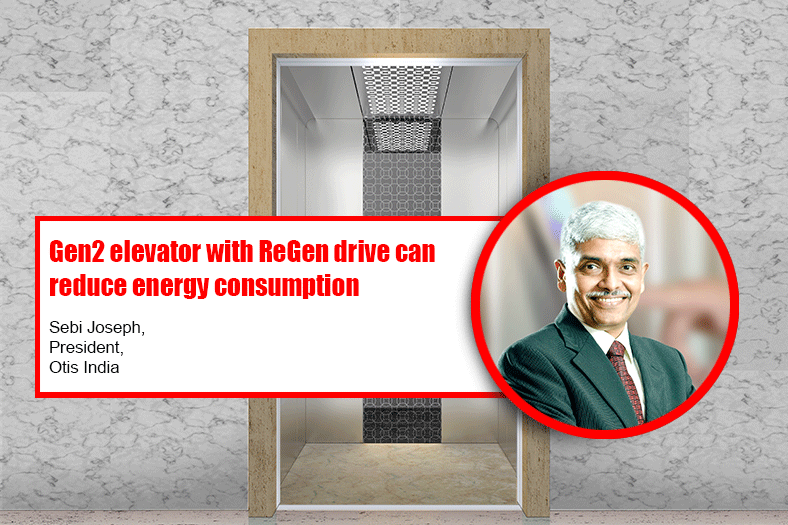Gen2 elevator with ReGen drive can reduce energy consumption

Gen2 elevator can reduce it up to 75 per cent compared to traditional elevators with conventional drives. Otis has sold more than one million Gen2 elevators worldwide since its launch, says Sebi Joseph, President, Otis India.
How does Otis lifts aid in reducing energy consumption?
In the recent past, there has been an increased demand for “Green” elevators. Otis’ flagship products, the Gen2 range are geared toward efficiency whilst providing environmentally responsible features and benefits. Some of the key components of the Gen2 range are the coated steel belt, the ReGen drive, the permanent magnet machine and the Otis’ PULSE system all of which, when combined, increase the life, efficiency, safety and reliability of the elevator.
A Gen2 elevator with ReGen regenerative drive can reduce energy consumption by up to 75 per cent compared to traditional elevators with conventional drives. Otis has sold more than one million Gen2 elevators worldwide since its launch.
One reason for this tremendous success is that developers and building owners are becoming environmentally conscious and thereby aim for green certifications like LEED, etc. Otis’ Gen2 Equipment and ReGen Drive technology support these green buildings.
Especially for super high-rises, what are the trending technologies to ensure maximum elevator speeds without compromising on safety and comfort?
Existing Otis technologies such as our Compass Destination Management System, use standard two directional call buttons, passengers enter their specific floor in the Compass fixture. The system assigns passengers travelling to nearby floors to the same car. This minimizes the number of stops per trip, reduces car crowding and decreases travel times. CompassPlus can also help limit the number of passengers assigned to each elevator and allow for automatic operation to pre-defined floors.
What kind of emergency evacuation systems need to be in place to ensure that an elevator can be used in the case of an emergency evacuation? It is recommended that elevators not be used during emergencies like earthquakes, floods, fires etc. and that people instead take the stairs or follow posted egress protocol. Having said that, nothing is more important to Otis than safety. Otis’ founder, Elisha Otis, invented the elevator safety brake, making elevators safe for passengers and enabling the tall buildings of today. We continue that tradition, with a modern safety brake, which engages when the system detects that a car is descending too quickly, and other safety features including emergency lights and alarms are other standard features that come with most elevators.
Other Otis safety features include:
• Infra-red door protection systems, a door protection system that consists of invisible infrared beams across the entrance of the elevators. If any beam in the curtain is broken, the door protection system re-opens the elevator door instantly without touching passengers.
• The overload detection feature does not allow the elevator doors to close in the event that the car is carrying passengers beyond the specified limit. The elevator resumes operation only when the extra weight is removed.
Situational safety mechanisms
• The Automatic Rescue Device (ARD) is especially useful in places where the power supply is irregular. In the event of a power failure, the ARD will bring the elevator car to the nearest floor and will stay on that floor with the door open till the power supply is resumed.
• Seismic sensors installed in buildings are designed to detect earthquakes, with the idea of stopping the elevator at the nearest floor during a case of emergency. This ensures passenger safety as the Seismic sensor can be linked into the elevator controller and can halt the elevator after detecting an earthquake.
Other add-on safety features for elevators include fire alarm home landing, intercom, and emergency power operation.
Security and access features
With the technology upgrades that have taken place in the industry today, an elevator can also be used to protect tenants or building occupants from intruders, offering security from external threats. Secure Access technologies can require certain codes to be entered to allow access to particular floors. Additionally, the elevators can be programmed so that when a passenger inserts a card into the card reader, he or she will be allowed to register a call to certain floors only. This aims to prevent unauthorized access.
Especially for heritage buildings, what kind of elevators should be used so that they espouse and reflect its design sensibilities?
The modern Indian customer is now paying more attention than ever to elevators. Apart from being conscious about the elevator being green, the focus on energy savings, technology, safety and other critical features, the customer is now looking to create an interesting and engaging space within an elevator. They are looking for softer edges, etchings, patterns, different colours, materials and textures. In short, they are looking to add personality to their elevator space.
Otis has a range of aesthetics to suit the environment and looks that the customer wants to create. Customers can also choose from theme-based interiors with a package of fixtures designed to be complementary. Theme-based interiors save customers the hassle of trying to match finishes themselves and can work very well in certain contexts. Additionally, when attempting to develop a highly customized and specific elevator, it is best to consult with your elevator company in the very early stages.
Cookie Consent
We use cookies to personalize your experience. By continuing to visit this website you agree to our Terms & Conditions, Privacy Policy and Cookie Policy.









